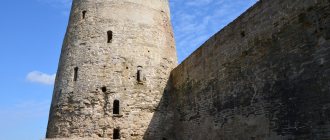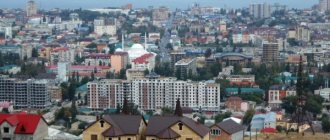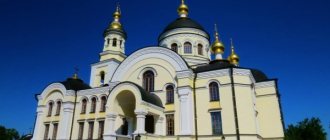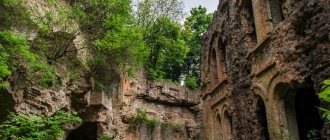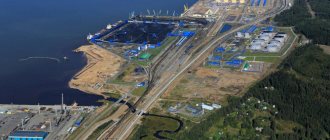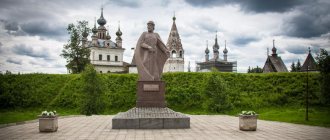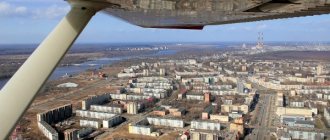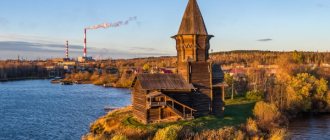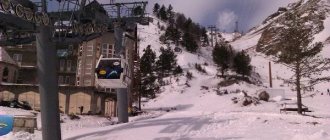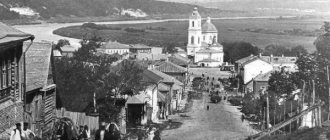Izborsk is a small village, its attractions attract lovers of historical tourism. It is located in the Pskov region, where it is called Old Izborsk. It is famous for its fortress, which defended the Russian land from attempts to be captured by Livonian and German knights for 2.5 centuries.
The city was founded at the end of the 7th - beginning of the 8th centuries on the shore of Lake Gorodishchenskoye with wooden, then stone fortifications. At the beginning of the 14th century, a stone fortress was built in a new place, which has survived to this day.
It is from here that Izborsk begins; the site of the ancient settlement is today called the Truvorov settlement. At the end of the 19th century, New Izborsk appeared - a railway station 12 km to the northeast, but the old city entered the history of Russia.
Top 10 most interesting sights of Izborsk
In Izborsk you can get acquainted not only with the fortress, there are natural attractions and objects outside the city:
- Izborsk fortress XIV century, was one of the most powerful for its time, was not captured by enemies for 2.5 centuries, the German knights nicknamed it “iron”.
Izborsk is famous for its ancient fortress of the same name. - The Slovenian springs are called the springs of the Twelve Apostles; their water is considered healing.
- Truvorovo settlement is the site of an ancient settlement, the predecessor of Izborsk.
- St. Nicholas Church located inside the Izborsk fortress, built in the first half of the 14th century. Never stopped working.
- The Korsun Chapel was erected according to the design of the St. Petersburg architect A. I. Vladovsky in 1929 on the site of the mass grave of Izborsk soldiers who died in the battle of 1657. Located outside the walls of the fortress.
- Museum-Reserve "Izborsk" located in restored merchant houses (19th century), consists of several exhibitions: ethnographic, archaeological, Orthodoxy and the Russian language.
- The Church of Sergius of Radonezh and Nikander of Pskov is located outside the fortress, the estimated time of construction is the second half of the 18th century. Inside is a collection of stone crosses and tombstones dating back to the Middle Ages. Currently administered by the Russian Orthodox Church.
- The Church of the Nativity of the Virgin Mary is part of the monastery, which was closed in the 18th century, and was built in the 17th – 18th centuries.
- Bogoroditsky spring inside a small chapel, next to one of the fortress towers. According to legend, it is associated with the Church of the Nativity of the Virgin. In ancient times, babies were bathed in it; today those who wish can do the same in the equipped bathhouse.
- Senno Pogost is located 1 km from the Novy Izborsk railway station. This is a small cemetery with a unique “winged” gate leading to it. On the territory there is a functioning Church of St. George the Victorious (mid-16th century) and a belfry of the same age.
In addition to the listed sites, there are other interesting places in the old town and its surroundings that you can visit on your own.
https://youtu.be/4KdHh8_FYuY
The beauty of nature of the Russian North
The surroundings of Izborsk are rich in the beauty of northern nature - dim, but attractive. Natural monuments are also included in the Izborsk State Historical-Architectural and Natural Landscape Museum-Reserve.
Slovenian keys
The Slovenian springs are karst-fissure springs that have been flowing for more than a thousand years. In the first geographical description of the Russian land it is written that Izborsk stands on the Slovenian Springs. For 3–4 km, groundwater passes through limestone and clay, purified and saturated with calcium and minerals. Therefore, spring water is considered beneficial and even healing. In a second, up to 4 liters of water are thrown onto the surface. There are only 12 springs in Izborsk, so they are sometimes called the Keys of the 12 Apostles.
The water flows out in the form of streams, and on the rocky surface it turns into low waterfalls. Tourists from different parts of the country come to the multi-level cascades. Local residents collect this water as drinking water, although, according to some reports, Rospotrebnadzor does not recommend using it for drinking.
Streams of mineralized water stretch for 25 km and flow into Lake Gorodishchenskoye.
The springs never completely disappear, but their “activity” depends on how dry the year was
Information for tourists:
- the keys are located next to the Truvorov cemetery (north of the fortress), exact coordinates: 57.714344°, 27.860846°;
- You can admire the cascades and wash yourself with cold water from the springs for free.
Izborsko-Malskaya Valley - a natural monument of the Pskov region
The Izborsk-Mal Valley is a natural monument with an area of 1,792 hectares, dotted with ravines and small never-drying streams. It is believed that it arose about 10,000 years ago (after the disappearance of the last glacier). It is in this valley that the main attractions of the museum-reserve are located: Izborsk Fortress, Gorodishchenskoe Lake and Slovenian Springs, Truvorovo Fortification and Truvorov Cross.
In the valley you can see several interesting geomorphological objects:
- the Snake Beam ravine, which is famous for its large number of crawling reptiles;
- Mill stream in the ravine of the same name, where 7 mills operated in ancient times. This stream is fed by underground springs, so the water level practically does not decrease. And from the mills only the remains of stone millstones have survived;
- the “Kipun” spring, similar to a geyser, the water in which comes out from under the outcrops of limestone tuff;
- tuff deposit.
Izborsk local historians told me what is remarkable about the local tuff. It's actually a stone that was once used to build churches and houses (a type of limestone). But Izborians are proud of something else. The entire western slope of the Izborsk valley contains a 12-meter layer of tuff. Local historians believe that these deposits are almost 10,000 years old. True, tuff mining is now prohibited.
Izborsk attractions are mainly located on the territory of the Izborsk-Mal Valley
You can walk around the valley at any time and for free. There are 2 options:
- self-inspection (if you are driving, you can leave it on one of the residential streets of Izborsk);
- as part of an excursion from the fortress (it will take less time).
Gorodishchenskoye Lake
Gorodishchenskoe Lake is a reservoir 0.5 km long and 0.25 km wide. The average depth of the lake is 3 m. The reservoir is fed by the Slovenian Springs, the Smolka River and underground springs. The water temperature reaches 17 oC in the hottest weather; in the summer you can swim here. There are a lot of algae at the bottom of the lake (more than 200 species), and the surface of the water is covered in places with water lilies. Local fishermen like to go to the reservoir, as there is a lot of fish here (rudd, pike, bleak, etc.).
Tourists here also like white swans. The birds are accustomed to the almost constant presence of people on the walkways. Sometimes swans swim to the shoreline to eat from human hands. Birds do not fly away from Lake Gorodishchenskoe even with the onset of cold weather.
In Lake Gorodishchenskoye, the water is always cool, since the reservoir is replenished by underground streams.
Lake Gorodishchenskoye is located at the lowest point of the Izborsk-Mal Valley.
Architectural objects and monuments of Izborsk
The main architectural attraction of Izborsk is the 14th century fortress. This is a unique fortification structure of Ancient Rus', which has not been rebuilt since its foundation. It has a triangular shape in plan. The outer parts of the powerful walls are made of slabs of local limestone and fastened with lime cement. Such a successful composition eventually turned into a limestone monolith.
The internal space was filled with boulders and slabs, then filled with clay mortar.
The thickness of the walls is 3 - 4 m, height 7.5 - 10 m. Inaccessibility was ensured by steep cliffs and ditches. Crosses - amulets - are “embedded” in the western wall; Livonian knights attacked from this side. The walls have been partially restored; along the top there are paths made of boards, covered with awnings. The stands contain information about Izborsk and its attractions.
Some sections of the walls have been cleared of vegetation and preserved for preservation. On both sides, to protect the entrances, zahabs were built along the walls - narrow long corridors-traps, where attackers fell after destroying the outer gates. The space of the zahabs was shot through from the towers, so it was almost impossible to reach the main gate.
The Nikolsky Zahab has been restored, and visitors pass through it into the courtyard . The area around the fortress was visible from seven towers, 6 of them survived, one collapsed in the 19th century and was discovered in 2011 by archaeologists. The towers rose 12 - 19 m, had walls up to 3 m, and were 10 - 12 m in diameter.
The oldest of them, Lukovka, was probably part of the original wooden walls - the only stone structure of the fortress. Subsequently, the walls were replaced by stone ones, moved a little outward, and the tower found itself in the inner fortress space. Its loopholes are directed outside and inside the courtyard, providing protection to the soldiers on the last line of defense.
The basement housed an arsenal and a powder warehouse. This is the only option for internal location in the surviving fortresses of Ancient Rus'. Today the tower has been restored, there is an observation deck on it, where you can climb.
The remaining towers are integral with the walls, protruding outward for better visibility and easier cannon fire.
The highest (19 m) Tower had 6 tiers of cannons and a wooden superstructure for sentinels, which made it even higher. An “alarm” bell was mounted on the Kolokolnaya tower; its alarm sounded far throughout the surrounding area, declaring the alarm. After the construction of the bell tower of St. Nicholas Cathedral, it was moved to it.
The hexagonal Talavskaya Tower defended the zahab; traces of shelling with stone cannonballs, presumably in the 16th century, are visible on its walls. All towers, except Lukovka, have been partially restored; it is impossible to climb them.
Izborsk fortress
The main attraction of the city , which is depicted on souvenir postcards and advertising brochures, is the stone Izborsk Fortress , which played a huge role in the formation of the Russian state and the protection of its western borders and Catholic spiritual orders of knighthood.
The total internal area of the fortress is 2.5 hectares, and the thickness of the walls reaches 3 meters in some places. It was originally built of wood, but was later rebuilt in stone. A defensive ditch was dug around the fortress, and later a second ring of walls was built. From a bird's eye view, the Izborsk Fortress is an irregular triangle with six towers, well integrated into the landscape. Another tower was demolished, but its foundations have now been excavated. The fortress towers are called: Lukovka (the oldest), Vyshka (the most powerful and tall), Kolokolnaya, Talavskaya, Ploskaya, Temnushka and Ryabinovka.
It is noteworthy that Izborsk became the second stone city of Russia after Staraya Ladoga . The military significance of the Izborsk fortress was lost after the end of the Northern War. For a long time, the fortress remained abandoned until it was repaired in the 40s of the 19th century.
Address : Pechorskaya st., 39, Izborsk, Pskov region, 181518
Historical monuments of Izborsk
A unique monument can be called the Truvorovo settlement - the place where the famous fortress and Izborsk itself begin its history. According to legend, in the 60s of the 9th century, Rurik and his brothers, invited to Rus', landed at the high cape of Lake Gorodishche. The younger Truvor remained to reign in the fortress, which was built on the site of a Krivichi settlement in the 7th – 8th centuries long before the appearance of Pskov.
Truvor led the reconstruction of the town and fortifications and soon died. The fortress was completed several times. At the end of the 11th century it was “Praizborsk” - a strong fortress city that protected the Pskov land from invaders. Powerful stone walls, a high tower, warriors and ordinary residents-artisans - everything served to repel the raids of the swordsmen and Livonian knights.
Many times the fortress was captured by enemies and returned to Rus'. It is believed that a wooden St. Nicholas Church was built in the ancient fortress, which remained standing in its place after the inhabitants left. In the 30s of the 14th century, a new, more powerful fortress was built on Zheravya (Crane) Mountain, located 0.5 km to the side.
The old fortress and residential buildings gradually fell into disrepair; the St. Nicholas Monastery arose in its place, and the church became part of the monastery buildings. Near the church there is an old cemetery, some of the graves are quite ancient, some are almost new. On its outskirts there are preserved gravestones and a large cross more than 2 m high with carved incomprehensible signs.
Local legends claim that Prince Truvor lies under the cross, which is why it is called Truvorov. There is another opinion that the prince was reburied under the St. Nicholas Church during its construction. St. Nicholas Church on the site was erected on the site of a wooden one that burned down in the 17th century on the territory of the monastery of the same name, which ceased activity in the second half of the 18th century.
From that moment on, the church became a parish church. The modest appearance corresponds to the canons of Pskov temple architecture, which makes the building a valuable example of its time. Bright white walls with black stone crosses, a characteristic three-tiered belfry and a small bell-shaped dome stand out against the greenery, telling about life in the distant past. In 1961 the church was closed.
Truvorovo settlement, Truvorov cross, St. Nicholas Church are witnesses of the formation of Rus'.
House of merchant Shvedov
Merchant Shvedov is a wealthy entrepreneur of pre-revolutionary Russia, engaged in the trade of flax and printed material. In Izborsk he had a small estate, including a wooden one-story house and outbuildings - a stone barn and a bathhouse. After his death, the estate became the property of his nephew, and in 1988 it entered the balance of the Pskov region, with the participation of which a unique museum was organized dedicated to the culture and life of the Finno-Ugric Seto (Seto) tribe.
In ancient times it was called the Pskov Chud. The basis of the museum exhibition is made up of unique ethnographic materials found during expeditions in the Pechersk region over the past 30 years. Visitors can also get acquainted with the interior of the house of a wealthy citizen of the 30s of the 19th century . The museum's collection contains unique photographs, merchant household items, as well as original furniture that has survived to this day.
The exhibition dedicated to the set will introduce visitors to traditional clothing and household items - spinning wheels, dishes, ritual towels and tools. A special place is occupied by the collection of samovars, both factory-made and handicraft. The decoration of the museum is a working German harmonium from the 19th century .
Address : Pechorskaya st., 32, Izborsk, Pskov region, 181518
Interesting museums in Izborsk
Izborsk, whose sights testify to its history, invites you to visit the Museum Quarter on Pechorskaya Street. Merchant houses typical of the city in the 19th century have been partially reconstructed or rebuilt here.
Museums:
- In the house of merchant Anisimov (1902) an exhibition was opened about the history of Izborsk “... from the beginning of Russia to the Battle of Poltava”. The results of the work of archaeologists at excavations, characteristic stone crosses, and military equipment from different times and countries are presented. There are halls that show the life of the city in the Middle Ages - everyday life, clothing, crafts, jewelry, and weapons of the defenders. The museum uses new technologies to create interactive showcases, use holograms to display artifacts, and show films. In the outbuilding there is another exhibition dedicated to the work of the artist Peter Ossovsky. Each composition is accompanied by a text by the writer Valentin Kurbatov. The theme of the exhibition: Russian literature and the Orthodox faith.
- The house of the merchant Belyanin, built at the end of the 19th century, was given to local history of Izborsk Here you can get acquainted with the interiors of the 19th – 20th centuries, documents, photographs. Each room presents materials about prominent residents of the city or its guests, historical events and relevant documents, posters, letters.
- The house of the merchant Shvedov was built anew on the preserved basement; the builders accurately reproduced the old estate. Here is a museum about the culture of the small people of Sets and Russian Izborians who lived in the common territory. The exhibition includes a collection of samovars, products from the weaving factory of the owner of the house, folk costumes, and authentic household items. Exhibitions of folk art are organized periodically.
In the same quarter there is a museum cafe “Pancake”, a souvenir shop, and also the burial ground “Skudelnya” with stone crosses has been preserved.
How to get to Izborsk
There are several ways to get to Izborsk:
- by bus (No. 207 or No. 126) from Pskov from the bus station (Vokzalnaya Street, 21) or from Pechory from the bus station (Pobeda Square, 2);
- by train from St. Petersburg, Moscow and other cities with a transfer to a bus in Pskov;
- by car in a westerly direction from Pskov or St. Petersburg along the E95 highway (P-23) or along the M9 highway from Moscow;
- by plane from Moscow, St. Petersburg, Rostov-on-Don, Krasnodar, Sochi, Voronezh, Kaliningrad, Saratov and other cities with a transfer to a bus in Pskov;
- by taxi from any city (the cost of travel from the Pskov bus station to Old Izborsk is on average 500–800 rubles).
From the Novgorod and Leningrad regions you can get to Izborsk through Pskov, and from the Moscow region - through Pustoshka, Opochka and Ostrov
Temples and cathedrals of Izborsk
Izborsk, whose attractions attract guests belonging to different faiths, invites you to visit holy places. St. Nicholas Cathedral was built inside the Izborsk fortress. In 1341 it was mentioned in the chronicle as active, in connection with the unsuccessful siege by the Livonian knights.
During the construction of the temple, slab limestone was used, which, together with original architectural techniques, ensured stability and strength. Such qualities were necessary for the fortress church, which, during a siege, the enemies sought to destroy first. From the outside, the complex is a typical example of northwestern cathedral architecture of its time.
It's cramped inside, but the high position of the dome creates volume. In the middle of the 19th century, a low bell tower was added, blending with the appearance of the temple. The first bells for it were removed from the Bell Tower of the fortress. At the end of the 16th century, the temple was elevated to the rank of cathedral. At the end of the 19th century until 1917, a parish school operated at the church, where children of all classes were educated.
The Church of the Nativity of the Virgin Mary is located outside the fortress; in the 16th century it was part of the Nativity Convent. The modern version was built at the beginning of the 18th century to replace a burnt wooden one at the site of limestone mining for the fortress. In the 60s of the 18th century, the monastery closed and the church became a parish. The walls of the temple are made of limestone slabs, and the same low fence surrounds it.
An interesting solution for the belfry - it seems to continue the wall, making the façade look more massive.
The church has preserved a carved iconostasis of the 18th century, made of wood, as well as ancient images of Fryazhskaya icon painting. Crosses from the churchyard were inserted into the walls of the southern aisle; its graves came under construction. Part of the cemetery still exists today. The church is open and receives not only parishioners, but children come here for Sunday school.
Not far from the temple there is the Bogoroditsky spring, over which the chapel of Serapion of Izborsk was built by modern craftsmen. According to legend, it was he who founded the Nativity Monastery and was buried under the temple. It is believed that the water of the spring is healing; inside the chapel there is a bathhouse where babies are brought for bathing for the sake of health, pilgrims come for holy water.
How many days to spend in Izborsk
Izborsk (museums, fortress, temples, etc.) can be explored in 1 day. If you are a lover of outdoor recreation, you can stay in the Izborsko-Malskaya Valley or, for example, near Lake Gorodishchenskoye. In this case, you can rent a house at one of the local camp sites.
I travel a lot around Russian cities. Sometimes, having found some beautiful place, my company stays overnight right in the forest/mountains. For such cases, there is an irreplaceable thing - a tent, which takes up little space in your backpack. For example, my one-person tent fits in the bottom of an 80-liter backpack. This tent can easily sleep 2 people (or even 3). True, this method of spending the night outdoors on a budget is convenient in summer or spring. With the onset of cold weather, spending the night on practically bare ground is dangerous for your health.
If you come for a few days and have some time left after visiting the main attractions of Izborsk, then visit the Malsky Monastery.
Malsky Monastery
Malsky (Malsky Spaso-Nativity) Monastery was built in the 15th century. It was planned that monks would live here, but in the 16th century the monastery already had 2 churches, and 12 monks lived here. Russians and representatives of the Seto people came to the church. And by the end of the 16th century, the wooden buildings of the monastery were destroyed by the Hungarians. A few years later, the restored monastery was destroyed again - this time by the Swedes.
At the beginning of the 18th century, Empress Anna Ioanovna ordered the restoration and strengthening of the temple buildings. The Peace of Nystadt of 1721 was concluded between Russia and Sweden, and the temple was headed by Bishop Raphael Zborovsky. The monastery was rebuilt and strengthened.
In pre-war times, the object became part of Estonia, and returned to Russia only in 1945.
Since the Great Patriotic War, when the region was occupied by the Nazis, the inscription “Beware of mines!” has been preserved on the inner wall of the altar semicircle of the basement of the refectory church.
Information for tourists:
- The Malsky Monastery is located between Izborsk and Pechora (18 km from Izborsk);
- You can visit the temple for free and at any time.
Parks and natural attractions of Izborsk
Izborsk is located in a picturesque area; its attractions are included in the list of natural monuments of Russia. The Izborsk-Mal Valley is one of them. On an area of about 1.8 thousand hectares, there are rare and endangered species of plants and animals, unique landscapes created by ancient glaciers, several lakes, and different types of swamps.
A mixture of flora and fauna species characteristic of different natural complexes - coniferous and broad-leaved forests, forest-steppe, limestone soils - has been recorded here. Groundwater flowing to the surface in the form of numerous cold springs is observed in connection with the development of karst cavities.
One of the group outlets feeding Gorodishchenskoye Lake is called Slovenian springs. Water flows out in powerful jets from cracks on the slope, forming small waterfalls. Tourists and locals come here and take the water with them, as it is considered healing.
Every year on Friday of Easter week, a procession of the cross leads from the St. Nicholas Cathedral to the Slovenian springs, led by the Metropolitan of Pskov.
If you walk along the stream formed by the merging springs, you will soon come to the shore of the lake, where many ducks and swans live. They eagerly await guests, accustomed to being fed.
Tips for staying in Izborsk
Here are some tips for your stay in Izborsk:
- when visiting the fortress, follow strict rules (do not walk on the walls, do not light fires, do not pick flowers, etc.);
- when walking to the Slovenian Springs, do not climb high rocks or a steep wall (you may slip);
- Before visiting the fortress towers, study the safety rules (do not climb into loopholes, do not lean over the railings, etc.);
- treat water from natural sources with caution (drinking it can be dangerous);
- do not cut down trees or make fires in the territory of the Izborsk-Mal Valley;
- There may be problems with withdrawing cash (there are few ATMs here), so prepare the required amount in advance;
- if you are traveling for several days, take care of warm clothes (it is cool in the valley at night);
- if you go for a walk in the dark or early in the morning, take a flashlight with you (there is heavy fog here due to cool water bodies);
- Prepare your tourist map in advance.
Tourists I know told me that Izborsk has a special system of paying for visiting museums. You can buy a “single ticket” (cost 150 for schoolchildren, 300 for pensioners and students, 500 for adults and 800 rubles for a family), which will give you the right to visit both the fortress and all exhibitions with one ticket. This is beneficial if you are interested in the entire city, and not a specific object.
It’s better to start exploring Old Izborsk from the Truvorov settlement and the Izborsk fortress
Modern objects interesting to visit
Izborsk, whose sights date back to different historical eras, has modern interesting objects.
Memorial Sacred Hill
In the fall of 2007, a Poklonny Cross was erected to the side of the fortress as a symbol of the memory and glory of the people of Russia. The defenders of Izborsk fought at this place; fallen soldiers and townspeople who stood shoulder to shoulder were buried here. The 8 m high cross is mounted on a hill-shaped foundation made of large boulders.
At its base, soil was poured from many cities and villages, from battle areas of different times, from the graves of prominent figures. Until now, guests who specially come to the Sacred Hill memorial take the soil with them.
In 2012, the chapel of the Sovereign Icon of the Mother of God, built near the Worship Cross, received its first visitors . The small temple does not violate the general architectural style of the churches of Izborsk.
Hotels
Hotel complexes in Izborsk fit into the appearance of a historical place, offer a break from the noisy city with a stove or fireplace, a Russian bathhouse, and provide modern amenities.
Hotels:
- The guest house of the Izborsk Museum-Reserve was built near the fortress and Slovenian springs. Its appearance resembles typical Pechora houses - the lower floor is made of limestone slabs, the upper floor is wooden. The interiors are designed in Russian style, the rooms are heated, you have the opportunity to use the kitchen or go to the museum cafe. The hotel accepts no more than 20 people. The possibility of booking must be clarified by phone or email.
- Guest complex "Izborsk" represents a group of merchant estates after restoration. The houses are architectural monuments of the late 19th – early 20th centuries. Guests can enjoy comfortable rooms with modern amenities, a safe, heating and air conditioning. Daily cleaning is required. There is a business center, secure parking, and bicycle rental. Active recreation options: horse riding, fishing, cycling, board games. Services: free Wi-Fi, laundry, ironing, transfer from/to Pskov, parking. For children there is a playground on the street, a play area in the house, animators, children's TV channels, and a separate menu. The restaurant has indoor and patio seating. You can order lunches delivered to your room or packed breakfasts to take with you on your walk. Smoking is prohibited; there are special areas for this. Check-in at 14:00, checkout until 12:00. Address: st. Pechorskaya, 13, not far from the fortress.
- The Izborsk Park guest complex consists of several wooden houses, a Russian bathhouse, and a refectory. Modern rooms are decorated in Russian style with elements of rustic interiors, daily cleaning is guaranteed. There is everything for relaxation - stoves, heated floors, TV, bathroom. There is an outdoor playground and a separate playroom in the house for children. You can order grocery delivery, lunch to your room, or breakfast to take with you for a walk. Fans of active recreation are provided with rental bicycles and tennis tables. There is secure parking on site. Transfer from/to Pskov is available by prior arrangement. Check-in at 14:00, checkout until 12:00. Address: st. Pechorskaya, 43, not far from the fortress. Smoking is prohibited; there are special areas for this.
| Name | Price, rub./day | Note | Animal accommodation |
| Museum Guest House | 1500 — 3500 | Check prices by phone | Check by phone |
| Complex "Izborsk" | 1900 – 4700; apartments 7000 – 9000 | Breakfast included | Paid separately |
| Complex "Izborsk-Park" | 2500 — 5000 | No internet, cash payment | Paid separately |
In Izborsk hotels you can book interesting excursions or just relax.
Excursion routes
The excursion “By bike around Izborsk” begins on Pechorskaya Street, continues to the Truvorov settlement ensemble, then along field roads to the village of Malo (museum of the Seto people), from there to the Malsky Monastery. The end of the route on Pechorskaya Street with a visit to the Slovenian springs. Cost for 1-5 people 4380 rubles, duration 2-3 hours, range about 9 km. Adults only.
The walking tour “Understanding Izborsk in 2 hours” starts from the Truvorov settlement complex, moves to the Slovenian Keys and Gorodishchenskoe Lake, then visits the fortress and St. Nicholas Cathedral. Cost for 1-7 people 2500-3000 rubles, duration 2-3 hours.
The Izborsk car tour route covers the main attractions: Truvorovo ancient settlement, Slovenian springs, the fortress with St. Nicholas Cathedral and merchant houses in the Museum Quarter. If desired, stop at a cafe for lunch. Duration 3 hours, client transport or rental, cost 2000 or 4000 rubles. respectively.
What time of year is best to come to Izborsk
The ideal time to relax in Izborsk is summer. Everything is green, even the old fortress looks more medieval. In addition, in winter you won’t be able to walk around the valley for a long time. There are no special seasonal attractions in Izborsk, but paragliding flights are conducted over the valley in late spring. Fans of winter recreation will appreciate the Slovenian Springs - when the water freezes, fancy slides are formed (very beautiful as a background for photographs).
Paragliding in Izborsk
There are few places for paragliding competitions in the northwestern part of Russia, so the Izborsk hills and slopes are popular. Athletes gather mainly at the Truvorov settlement and start with the arrival of a “lucky” wind. Usually flights are carried out with north-easterly winds in late April - early May.
Video: paragliders over Izborsk
Top 5 places suitable for holidays with children
Izborsk, whose attractions attract tourists of different age categories, is interesting for children:
- In the Izborsk fortress you can listen to a story about its history, go down the secret passage or into the powder magazine, walk along the walls, look at ancient cannons, and climb the Lukovka tower.
- In good weather, a walk to the Slovenian springs is possible.
- The Izborsky Ostrich eco-farm is home to not only exotic birds, but also reindeer, Romanov sheep, rabbits, raccoons, squirrels, and geese. You can feed the animals and play on the playground.
- The Museum of the History of Izborsk (house of the merchant Anisimov) has an interesting collection of equipment and weapons of warriors from different countries and times. You can hold some exhibits in your hands.
- If you come with children in early August, you can go to the Iron City festival: a crafts fair, tournament battles of horsemen, archery competitions, foot fights and the performance of a 15th century battle. The finale includes a concert and fireworks.
It is necessary to have comfortable shoes and a supply of dry clothes for a walk to the springs.
Self-guided walking route in 1 day
For those staying in the guest house of the museum-reserve, it is convenient to start the route from the Truvorov settlement:
- A country road leading around the fortress along the edge of a cliff leads to the Truvorov settlement complex. At the settlement, stop at the cross and go to St. Nicholas Church.
- Return along the same road to the fork at the Slovenian springs, go to them, to the shore of Lake Gorodishchenskoye, feed the swans and ducks.
- Go back to the road to the fortress and walk to the main entrance. Nearby there is a museum cafe, go have a snack and relax.
- Walk through the Nikolsky Zahab into the fortress, explore the courtyard, climb the wall and observation deck on the Lukovka tower, go down to the powder magazine. Visit St. Nicholas Cathedral. Coming out of the Nikolsky Gate, stop at the archaeological site of the Flat Tower with a well frame.
- Relax in a cafe with tea and pancakes, go out onto Pechorskaya Street. In front of the guests are 3 restored merchant houses with museum exhibitions. See as much as you have the strength and desire to do.
- Return to the fortress, go to the souvenir shop, go around the fortress along the road under the walls and head to the guest house.
If you stay at the Izborsk-Park or Izborsk hotel complexes, it is better to start your route with museums or a fortress.
Interesting Facts
Tourists pay attention to popular sites, but there are facts no less interesting:
- Izborsk had an ancient coat of arms, which modern researchers have tried to restore. It had the shape of a shield usual for heraldry, divided into 3 fields. The top black one bears the inscription “IZBORSK”, the middle blue one means the sky - a sign of honor, fidelity and the Blessed Virgin Mary. The lower part is in the shape of a green hill with three cranes (an emblem of vigilance). It is believed that this is a symbol of Zheravya Mountain, where a new fortress was built.
- At the end of the 14th century, Izborsk was chosen as the place where the peace treaty between the Hanseatic League and Novgorod was signed.
- At the beginning of the twentieth century, N.K. Roerich visited the city and painted several paintings.
- The Izborsk Hills are popular with Russian paragliders, who come here to fly in the updrafts.
- In June and August, the “Isaborg” and “Iron City” festivals are held on the territory of Old Izborsk with the reconstruction of historical events.
- From time to time, the fortress, temples and ancient houses become a film set. Such famous films of the 20th century as “Andrei Rublev”, “Star of Captivating Happiness”, modern films “Sukhodol”, based on the fairy tale “Reinecke the Fox”, “The Wall” were filmed here.
Interesting events take place in Izborsk every year, for example, a parade of snowmen, exhibitions of paintings and lithographs. Izborsk is an ancient settlement. Its sights testify to the history of Russia, the traditions of the Pskov people, and the courage of the country’s defenders. The museum complex welcomes guests of all ages at any time of the year.
Article design: Oleg Lozinsky
